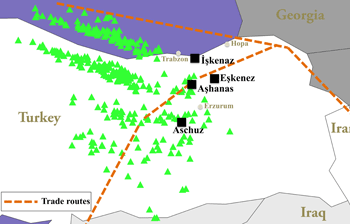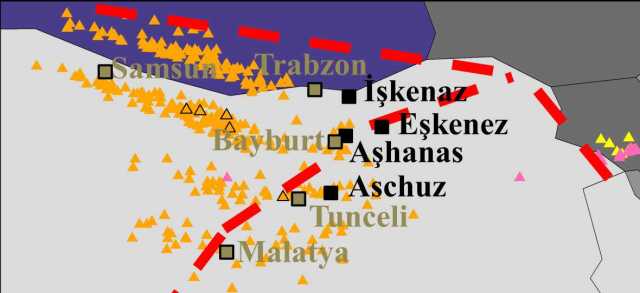
Jewish Genetics - Forward Magazine Makes Elhaik's Work Go Viral
A few weeks back, we wrote about Dr. Eran Elhaik’s new and interesting work on tracing the roots of Ashkenazi Jews in Northeastern Turkey.
New Paper by Elhaik Shows that Ashkenazi Jews Came from Northeastern Turkey
Elhaik relied on his previously published population genetics algorithm that could trace the ancestral origin of someone to within a village based on genomic data. That work was done in collaboration with National Geographic.
Nevertheless, Elhaik’s latest paper did not catch as much attention as it deserved, until the Forward magazine decided to trash it using the opinions of a bunch of ‘scholars’ with no population genetics background.
Dont Buy the Junk Science That Says Yiddish Originated in Turkey
The core of their criticism is rather hilarious, because they elevated the peripheral part of Elhaik’s paper to ‘central evidence’, while downgrading his DNA evidence to ‘belief’ system !! In fact, the ignorance of genetics of their ‘scholars’ is downright scary, because they repeatedly argued how the results could change with the inclusion of Sephardic Jews. How can evidence derived from a person’s genomic data change with the inclusion of a completely different person?
Of the many dubious pieces of evidence presented to support Elhaiks unorthodox theory is the fact that four villages in ancient Turkey once had names that sounded something like Ashkenaz. Later in the film Elhaik explains, without a trace of humor, that Yiddish-speakers talk like Yoda and he even mentions Yodas use of unusual terms like Jedi and wookies to demonstrate Yiddishs linguistic properties. Dr. Elhaik, using a tool he designed called Geographic Population Structure, which he believes can pinpoint the origins of an ethnic group according to its DNA, published an article in the journal Genome Biology and Evolution in which he elucidates his theory.
-————————————————–
Elhaik wrote a detailed criticism of the Forward article in his blog, which we post below.
Responding to the criticism for Das et al. (2016)
In Das et al. (2016), we applied the Geographic Population Structure (GPS) algorithm to the genomes of Yiddish and non-Yiddish speaking Ashkenazic Jews (and other Jewish and non-Jewish populations) to study the origin of their genomes. Since genetics, geography, and linguistics are well correlated we surmised that the origin of the DNA would point to the origin of the Yiddish language. Surprisingly, GPS traced 93% of the samples to northeastern Turkey where we found four villages whose names may be derived from the word Ashkenaz. By the proximity of this region to Slavic lands and combined with other historical and linguistic evidence our findings were in support of Prof. Wexler’s Slavic hypothesis rather than the dominant Rhineland hypothesis proposing a Germanic origin to Yiddish.

The study has been published two weeks ago and has been picked up by the media. It has been received nearly 100% positive coverage in over 100 media outlets and numerous blogs. Expectedly, we have also received a bit of criticism, some of it will be addressed here and some of it will be ignored because it is merely ad hominem, not science.
Genetic criticism
None has been received, however some people have voiced their concerns about the implications of our results to their potential relatedness to the ancient Judaeans. I have commented at length on this issue to the Israeli Globes (Hebrew). Briefly, our study did not focus on the origin of Jews or even all Ashkenazic Jews, but rather the origin of Yiddish using a third of the Ashkenazic Jewish community for which genomic data were available. Testing whether one is related to the ancient Judaeans, Jesus, Moses, or Muhammad requires actually sequencing the genomes of these people and meticulously comparing it with modern day genomes looking for shared biomarkers. As opposed to the latter three we actually have plenty of ancient Judaeans skeletons that no one has ever sequenced (and probably never will). Why the DNA of the ancient Judaeans has not being sequenced and settle the question of relatedness once and for all is a question that should be directed to Israeli archeologists. It is most unfortunate that the members of the general public have been mislead to believe (no doubt after paying a lot of money to DTC companies) that they are related to ancient figures without any shred of evidence. However, this is not something our study aims to prove or disprove.
Methodological criticism
In “Scholars Blast New Study Tracing Ashkenazi Jews to Khazars of Ancient Turkey” Mr. Liphshiz cites two academics who criticized on our study, or more precisely, criticized the press release: most blasting indeed. First is Prof. Sergio DellaPergola, a demographer who proposed that including Sephardic Jews would have changed our findings.
serious research would have factored in the glaring genetic similarity between Sephardim [sic] and Ashkenazim [sic], which mean Polish Jews are more genetically similar to Iraqi Jews than to a non-Jewish Pole.
First, let us start with a basic biology. Each person has unique DNA: studying the DNA of non-Ashkenazic Jews would not change the DNA of Ashkenazic Jews nor the predicted origin of their DNA (i.e., ancient Ashkenaz in northeastern Turkey). GPS is an unbiased algorithm, that is, including or excluding other samples does not change the results for the test samples. GPS also cannot relocate the villages bearing the name of Ashkenaz to Germany.
Second, Iraqi and Iranian Jews are extremely similar, and the latter were indeed included in the study. The genetic similarity between Ashkenazic Jews and Iranian Jews was explained by their shared Iranian-Turkic past.
**Had Prof. DellaPergola bothered to read our study rather than rely on the above figure, which was produced for the press and for simplicity included only Ashkenazic Jews, he would have found that we have analyzed Sephardic Jews **(The yellow and pink triangles below in Figure 4 from Das et al. 2016 correspond to Iranian and Mountain Jews considered “Sephardic Jews”).

Third, to date, only three biogeographical analyses were carried out for Ashkenazic Jews. The first was done by Elhaik (2013) who mapped Ashkenazic Jews to western Turkey, ~100km away from ancient Ashkenaz and included only Ashkenazic Eastern European Jews. The second was done by Behar et al. (2013), who included both Ashkenazic and Sephardic Jews and mapped Ashkenazic Jews to Eastern Turkey, ~600km away from ancient Ashkenaz. Using a large dataset that include mostly Ashkenazic Jews and some Sephardic Jews and a more accurate algorithm, the third study by Das et al. (2016) discovered ancient Ashkenaz. In summary, all three studies pointed to Turkey. Interestingly, Behar et al. (2013) interpreted their results in favor of a Middle Eastern (Israelite) origin, although it is unsupported by their data. The inclusion of Sephardic samples did not change the Turkish geo location for the latter two studies.
Unlike Prof. DellaPergola, historian Prof. Shaul Stampfer, went to an even greater length enlightening us with his well supported criticism of our study:
It is basically nonsense
Behind the scenes, Prof. Stampfer is harassing people involved in the preparation of my papers alleging that population description was omitted from Elhaik (2013). Unfortunately, this is another case of an academic who may consider reading papers a luxury. A brief glance at the method section and yes, most unfortunately, the supplementary materials, would have revealed a very detailed description of all population and individuals studied. Unless capable of reading and understanding genomic studies, Prof. Stampfer may be advised to focus on the controversy over Shechita between Hasidim and Mitnagdim, a field which earned him the respect of his peers.
Linguistic criticism
The most interesting criticism, in my opinion, is the one that focuses on the linguistic aspects of Yiddish. It is worth clarifying that we did not carry out a linguistic but rather a genomic study that yielded biogeographical predictions, which were interpreted in favour of the Slavic theory over the Rhineland theory.
Mr. Dovid Katz said to The Jewish Chronicle that:
There is not a single word or sound in Yiddish that comes from Iranian or Turkish, and older Western Yiddish thrived before there was a single Slavic- derived word in the language.
The following response was provided by Prof. Paul Wexler, co-author of Das et al. (2016):
Unfortunately, I am unable to reply in the most appropriate manner, which would require publishing my collection of about 800 pages (single-spaced) of Iranian, Turkic, Tocharian, Mongolian and Chinese influences in Yiddish-both in the latter’s western and eastern variants. Mr. Katz’s claim that there are no Oriental elements in Yiddish and that even Slavic elements do not enter Western Yiddish until centuries after the alleged rise of the Yiddish language in the German lands, is totally false. Mr. Katz’s remarks are more of an emotional tirade than a scholarly statement. Apparently, Mr. Katz did not read (or did read but failed to understand) my recent articles on the subject of Iranian and Turkic elements, or my many books and articles dating from the 1990s showing the nature of the “Slavicity” of Yiddish. Indeed, to the best of my knowledge, Katz has no knowledge of Slavic, Iranian, Turkic, etc. so it would be nearly impossible for him to evaluate my writings and examples (which I hope soon to publish in a book form). Mr. Katz also does not appear to know about the pre- and post-World War II writings of Max Weinreich, the doyen of the field of modern Yiddish linguistics (1894-1969), whom I had the distinct pleasure of meeting personally. Weinreich wrote that German Yiddish from its earliest stages (10th c) was in contact with Sorbian, and possibly also with Polabian, two of the many Slavic languages which reached what is now modern Germany (both west and east) in the 7th century. Today, Polabian is extinct (since the late 18th c) but Sorbian survives in two variants in eastern Germany. To claim that there are no Iranian elements in Yiddish is very puzzling.
Surely, Mr. Katz knows that the Babylonian Talmud was edited in its final form by the 6th century, in a territory that was part and parcel of the Iranian Empire. All Talmudic scholars could tell him of the immense Iranian philosophical, religious, legal and linguistic imprint on the Talmud. Many of the Iranianisms in Yiddish passed via Judeo-Aramaic (the language of the Talmud) into written Hebrew and from there into the later Jewish languages of varying stocks. My claim goes further: namely, that Jews were intimately acquainted with Iranian dialects and could not avoid, or did not ever wish to avoid, importing hundreds and maybe even thousands of covert and overt Iranianianims into Yiddish, etc.
The existence of Iranianisms in Yiddish was known also to scholars of Iranian and Slavic. The very distinguished general and Slavic linguist, Roman Jakobson, wrote in the 1960s that Yiddish paskudnik, paskudnjak ‘scoundrel’, though it bore a very close similarity to the coterritorial Slavic languages, was ultimately of Iranian origin (it also appears in the Talmud). Under Ukrainian influence, the Yiddish Iranianism adopted non-Jewish Slavic form- except that -njak in the second variant, though theoretically possible in Ukrainian, is unattested. The Yiddish word has also been discussed in the Iranian linguistic literature. Is this “off-the-wall linguistics”, to quote Katz?
Finally, Mr. Katz seems to think that the term “Ashkenaz” has always been associated with the German lands, the alleged homeland for him of the North European Jews. I would advise Mr. Katz to read the writings of Sa’adya Gaon, the 10th century scholar from Baghdad who understood that Ashkenaz meant “Slavic” (he is not the only writer of that age who thought so). I would advise Mr. Katz to read the Caucasian ethnographic literature of the 1920s where the term Ashkenaz was still being used by local peoples, both Jewish and non-Jewish. I would advise Mr. Katz to have a look at the writings of Wilhelm Bacher, the eminent Iranianist, writing (around the turn of the 20th century) about a 14th-century Uzbek Jew who composed the first extant Hebrew-Persian dictionary and who described himself (a native of Urgench) as “Ashkenazic”.
I am very grieved by Mr. Katz’s ignorance, since I have known him since the 1980s. In those days he wrote several ground-breaking articles on Yiddish which earned him the respect and admiration of all Yiddishists. Unfortunately, he did not live up to his promise.
Das et al. study was published in GBE.